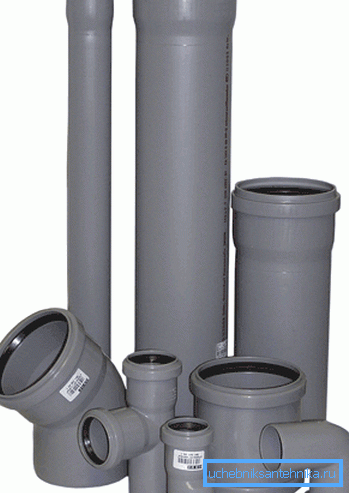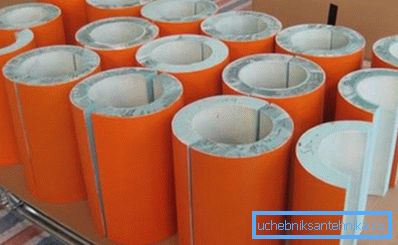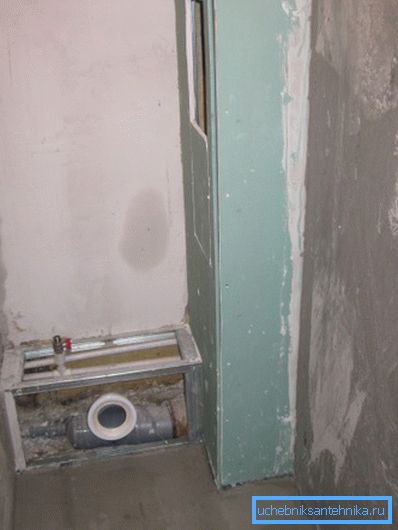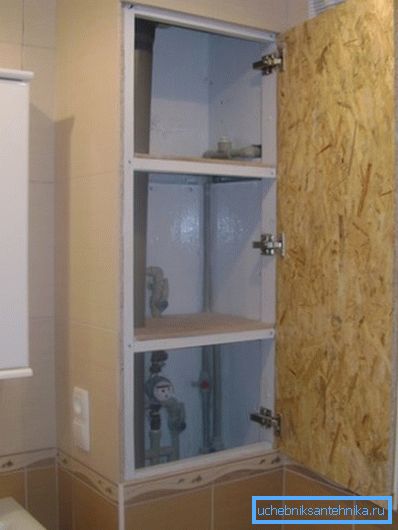Noise isolation sewer pipes in the apartment: simple and
The sound of a toilet drain from a neighbor's toilet is not the best accompaniment for a healthy sleep. What to do if the work of sewage is well heard in your apartment? Is there a noise sewer? How can be made insulation sewer riser with your own hands? Let's figure it out.

Sound propagation mechanism
From the point of view of acoustic oscillations, any hollow tube is an ideal waveguide: by re-reflecting from the walls, the sound with minimal amplitude loss can overcome large distances.
Curiously: during the Great Patriotic War, negotiation pipes were the only and absolutely reliable means of voice communication between submarine compartments.
However, in order for the sound to spread beyond the pipe, a combination of two factors is necessary:
- The walls of the pipe should have a high density and monolithic structure. Variable density contributes to sound absorption.
- The mass of the pipe (and, therefore, the thickness of the walls) should be negligible. The power of acoustic oscillation is simply not enough to make the massive walls resonate.
Materials
What is the sewer system made of?
The list of materials used, in fact, is not so long. Let us describe the key features of each of them - of course, with an emphasis on sound insulation qualities.
Cast iron
The undisputed leader. Its density significantly exceeds the density of all plastics. A solid thickness that compensates for low impact strength, and, accordingly, a solid mass perfectly quenches any sounds.

However, cast iron pipes are difficult to recognize as the best choice.
The reasons?
- Problems with transportation and loading due to the large mass of cast-iron pipes and fittings.
- Laborious processing. If the plastic sewage system is cut off at the place of an ordinary garden hacksaw or even with a sharp knife, the cast iron is either pounded with a chisel (with the risk of getting an uneven chip) or is cut by a grinder.
- Even more labor intensive installation. Believe me, to replace the cast-iron riser in the ceiling is very hard work.
PVC
Polyvinyl chloride - on the contrary, the antihero of our rating. It was these pipes that created the plastic glory of an exceptionally noisy material. The reasons are relatively high density and rigidity of unplasticized PVC, which allows manufacturers to make walls sufficiently thin for reasons of economy.

Polypropylene
Noticeably superior PVC to its rigidity, polypropylene, however, is the lightest of the existing plastics: its density is only 0.91 g / cm3. The noise of the pipes is noticeably lower, although it does not reach the unattainable ideal - cast iron.
Polyethylene
Breathes in the back of the head cast iron and is the undisputed leader among plastics. The density of polyethylene is only slightly higher than that of polypropylene; The key property that influences the soundproofing qualities we are interested in is exceptional elasticity. The material is practically incapable of propagating elastic waves (which, in fact, include sound vibrations).
In addition: to compensate for the low ring stiffness, the thickness of the walls of polyethylene pipes is made slightly larger than that made from PVC or polypropylene.
Costs
How much will it cost to lay sewers with each of the listed materials? Let's take the average prices for the best-selling when installing pipe risers - 110x2000 mm.
| Material | Price |
| PVC | 250 r. |
| Cast iron | 1400 r. |
| Polypropylene | 270 r. |
| Polyethylene | 305 r. |
An important nuance: polyethylene pipes are pressure pipes and are not completed with sockets. However, they are fully compatible with the polypropylene and PVC fittings. The wall thickness of the cheapest PN6.3 is 4.2 millimeters (versus the standard 3.2 for PVC and 2.7 for polypropylene).

Silent tubes
So, the most effective insulation of the sewer riser when using widely used materials is its replacement with polyethylene. However, the modern market is quite flexible and listens to the needs of consumers. As soon as there was a problem of poor sound insulation of plastic pipes, its solution also did not appear.
The assortment of leading domestic and foreign manufacturers have long been the so-called silent pipes. They are, as a rule, a three-layer structure, the middle layer of which has an increased density due to the use of mineral fillers. Together with the increased wall thickness, their use provides quite effective sound insulation.

Standard outer diameter and socket mounting makes all products manufactured using this technology fully compatible with standard plastic drainage. Materials used in the production - PVC and polypropylene. The retail price is not much higher than that of ordinary pipes: for example, a two-meter noiseless pipe with a diameter of 110 mm from the domestic company Sinicon will cost the buyer 320 rubles.
Soundproofing risers
Let's be realistic: few readers will rush to change sewers for some noise reduction. Is it possible to sewage pipes without insulation? (See also the article Pipes for domestic sewage: features.)
We give a description of several popular solutions.
Shell
Ideal insulation for sewer pipes - polyurethane foam or polyurethane foam shell. It is sold for the purpose of sewage insulation; However, both thermal and noise insulation are structurally identical - the material is a large number of closed air cells.
Of course, it will not be possible to use the shell everywhere: the water supply risers in line with the sewers can prevent them from being put on the riser.

Polyethylene foam
Noise isolation of sewage pipes with their own hands can be done in just 15 minutes using polyethylene foam, which is used, in particular, as a substrate for a laminate. The manual does not differ in complexity: the rolled insulation is wound around the riser in a spiral and fixed with plastic clamps. (See also the article Stub on sewers: features.)

Box
Finally, effective noise isolation of plastic sewer pipes that does not violate the aesthetics of the room is a plasterboard box. For the construction of the frame under it are used, as a rule, guide profiles UD and ceiling CD; moisture resistant drywall is attracted by 25-mm self-tapping screws with a pitch of 15-20 cm.

When constructing a box it is worth considering a couple of subtleties.
- It is better to provide a pair of vents at the bottom and top of the box. Air circulation through them will ensure its heating by the hot water supply system. This circulation is necessary to ensure that condensate on the cold water supply does not cause the ceiling to become wet.
In addition: in the houses built in the 60-90s of the last century, the risers were laid with black steel. They are damp and completely contraindicated.
- It is desirable that the box was easily folding. Sooner or later any communications need to be repaired; it is better that access to them does not require complete re-finishing of the bathroom.

Conclusion
We hope that our recommendations will help the reader to cope with annoying home noise. As always, additional information can be found in the video in this article. Successes!